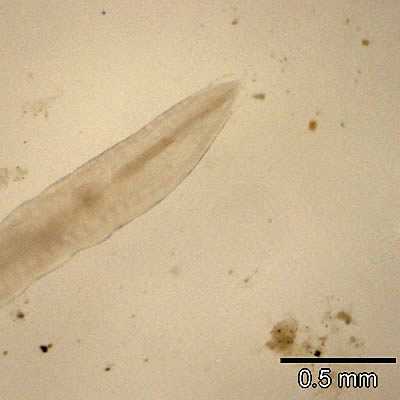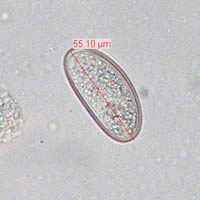
Case #151 - March, 2005
A 39-year-old female had a descending colon biopsy to determine the cause of symptoms that included chronic abdominal pain and discomfort. No pertinent travel history was known. Worm-like objects were detected during the biopsy, and some were recovered. The specimens were sent to the South Carolina state health department laboratory for identification. Lab personnel at the state took digital images (Figures A-C) and sent them to DPDx at CDC for assistance in making an identification via telediagnosis. What is your diagnosis? Based on what criteria?

Figure A

Figure B

Figure C
Case Answer
This was a case of enterobiasis caused by Enterobius vermicularis (pinworm). Diagnostic features were:
- the presence of cephalic inflations on the anterior end of the worm.
- an absence of spicules in the the tail, indicating this was a female worm. The tail of a female pinworm is long, tapered, and slender.
- the presence of eggs in the exposed uterus, confirming that this was a female pinworm. However diagnostic features could not be determined by the magnification at which the images were taken.
The DPDx Team asked laboratory personnel at the South Carolina Bureau of Laboratories to try to “tease out” some eggs, photograph them, and submit an image to verify the initial diagnosis. The image of the egg below shows a typical pinworm egg based on size (50-60 by 20-32) and shape (oval with one side flattened).

Figure D
More on: Enterobiasis
This case was kindly contributed by the South Carolina Department of Health and Environmental Control, Bureau of Laboratories.
Images presented in the monthly case studies are from specimens submitted for diagnosis or archiving. On rare occasions, clinical histories given may be partly fictitious.
DPDx is an education resource designed for health professionals and laboratory scientists. For an overview including prevention and control visit www.cdc.gov/parasites/.
- Page last reviewed: August 24, 2016
- Page last updated: August 24, 2016
- Content source:
- Global Health – Division of Parasitic Diseases and Malaria
- Notice: Linking to a non-federal site does not constitute an endorsement by HHS, CDC or any of its employees of the sponsors or the information and products presented on the site.
- Maintained By:


 ShareCompartir
ShareCompartir